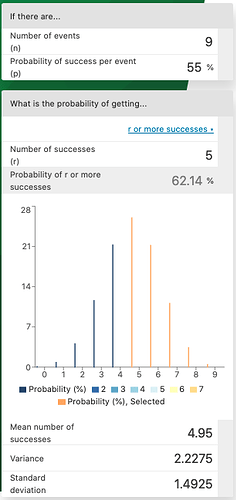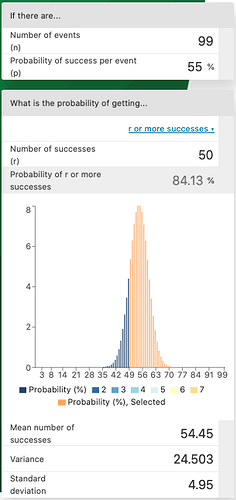Hello Friends,
While reading “The New Market Wizards”, I come across interesting discussion with Gil Blake.
Assume you have a stack of coins, and each has 55% chance of landing on head. That means, if you toss a single coin, the odds of getting more heads are 55%. If you toss nine coins, the odds of getting more heads than tails go up to 62%. And if you toss ninety-nine coins, the odds of getting more heads than tail go up to about 75%. He says that it is function of binomial probability distribution.
Can any one you please explain me how I can get 75% probability of heads when 99 coins are tossed ?
Thanks in advance!
Use this - Binomial Distribution Calculator
True.
It’s actually 84.13%.
Basically, n (number of events) and p (probability of success per event - 55%) is implicit. More heads then tails simply depend upon the number of events and that determines r (number of successes). For 9 events, it will be 5 and for 99 events it will be 50.
Binomial probability distribution basic formula is about finding probability of an exact outcome. And it can be extended by adding probabilities of all the outcomes in such “more than” wordings. Simply put, when you what to get the probability of getting more heads then tails in 9 events, you are trying to find the sum total of probability of getting exactly 5 heads + 6 heads + 7 heads + 8 heads + 9 heads => r = 5 (number of successes)
However, the practical application of this is much much harder -
- You have to find a system with 55% probability of success per event. Use all the technical indicators and its next to impossible to move the needle to even 51% over a very long set of data.
- It’s binomial. So you have to religious follow cut off points success or failure. But human nature will come in between making one cut profits short and extend losses.
- You need enough capital to have ample number of tries. This only works when number of events are large.
- And a little bit of luck for you need to take care of another probability, i.e. probability of continuous loosing streak you may have even if you have a cogent system (55% success) so that you can size your bets accordingly and not blow up your account in any unlucky losing streak. Though thats a whole new topic.
Anyhow, hope this helps.
1 Like
Just to make sure that you understand this correctly, given the way you worded this question: The book(?) is not saying that if you toss 99 coins, where each coin has a probability of 55% for landing heads, then the probability of the 99th coin being heads—or all the coins being heads(!!)—becomes 75%. What it says is that if you toss 99 such coins, then the probability that at least 50 of these coins lands heads, is more than 75%.
Hi Abhiwin123,
Thanks a lot. Very much helpful!
I have been testing this method since one year with very high success rate ( but without understanding concept). When I read this point in Gil Bleak discussion, it stuck me! And I got answer “why” success rate is high but did not no how ?.
In my case 1) I am increasing the probability by applying Elliott wave principle (most of the time Motive Diagonal triangles and corrective wave Triangles ) and 2) increasing probability by having more trails (say 70 to 100). 3) I almost never sell in loss. 5) picking based on sector diversification 4) I am sticking to fixed amount for each trail.
Thanks a lot for the Answer again!
Best
Can you elaborate this please what it means ?
How do you make sure of this ?
Hi Stonecold,
"Increasing probability by having more trails (say 70 to 100): I mean I buy 70 to 100 stocks with fixed amount. At a given time my portfolio has 70 to 100 stocks which are bought based on Elliott principles.
You can checkout my profile at Trader yvgoudar — Trading Ideas & Charts — TradingView
“I almost never sell in loss” > I always buy CNC (long term) and I simply don’t sell if stock is at loos. I simply wait for recovery : it may take days, week and at the max 3 to 4 months to recover.
Ok. Looks like you are doing a lot of those things right … Elliot Wave, Sector Distribution, Lots of Trails and Money Management.
Yeah. This will work good with Elliot Wave Theory because it is one of the few leading indicators like RSI. My statement about inability to find edge in technical analysis was mostly around lagging indicators. But Elliot wave has forecasting built in with its 5-3 rule and if you manage to avoid the down waves the probability of win can increase substantially.
However, this caught my attention -
My 2 cents … You should be ready to take limited losses. When you are not selling in loss you are losing on time. Plus the market has been trending for almost 1.25 years now. So this would have certainly worked in your favour. But not always …
If you rely on binomial probability distribution … its in the name - Zero or One. Trust the overall probability and the process rather than holding on to individual stocks or losses.
Have a good one … Cheers!
Agreed ! market is trending since 1.25 years and this may be also another factor. But what I noticed is that if you see Nifty 50 on monthly chart, Aug, Sep and Oct 2020 and March and April and June 2021 is almost FLAT. But it still worked.
“losing on time”. It is the compromise. When other horses are running, let some other take rest!. And one more point though! I always stick to Large cap and Mid cap. ( Very small % of Few cap). This is another level of safety which assures that trades at loss will come back in year or two.
You can check you my profile at Trader yvgoudar — Trading Ideas & Charts — TradingView
Thanks again.
Indeed. If @yvgoudar doesn’t sell at a loss, then I don’t see how the binomial distribution has any relevance to their computations. There are no “tails” if there are no loss-making sales! Perhaps they model some other aspect of their strategy as the tails of the coin toss.

